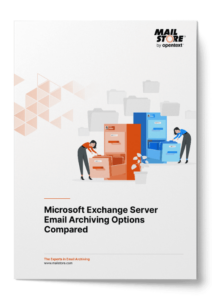
Microsoft Exchange Server Email Archiving Options Compared
You use Microsoft Exchange Server and want to archive your emails securely & long-term? Find the optimal archiving solution for your business.
You can expect:
- Overview of Microsoft Exchange archiving options
- Comparison of archiving methods based on seven criteria
- Expert knowledge about e-mail archiving with Exchange Server
Find the right archiving solution for your business
The need for email archiving has long-been a need for many organizations running Microsoft Exchange Server on-premises or Hosted Exchange. There are several reasons for this, such as minimizing the amount of mailbox data that needs to be backed up on a regular basis or establishing long-term retention of email for legal, compliance or regulatory reasons.
There are various options for email archiving and different aspects that you should consider. Should you use the native email archiving capabilities Microsoft is offering, or should you look for a third-party provider? Learn more about the different possible methods of email archiving in our white paper.
The archiving options for Microsoft Exchange Server
We’ll look at the archiving of Microsoft Exchange from a number of technical and business considerations and compare the following three possible methods:
Method 1 – Outlook AutoArchive (PST)
Outlook has long supported the ability to export contents of an Exchange mailbox into a portable archive file. While only having the limited functionality of a structured database file, Outlook Archives have been used to assist in archiving, backups and even migrations.
Method 2 – Exchange In-Place-Archiving
Microsoft Exchange offers the possibility of in-place archiving (also called in-situ archiving), for users to manage their archiving themselves. The archive mailbox is an additional mailbox that must be enabled for a user’s primary mailbox. The archive mailbox is accessible in specific Outlook clients and via Outlook on the web. This capability is specifically designed to help address archiving, but with a limited scope of functionality.
Method 3 – External Archiving Using a Third-Party Solution
Microsoft Exchange Server supports external email archiving solutions to address archiving needs beyond the basic functionality supported by the previous two methods. Solutions on the market today can be completely software-based (whether traditional software or a virtual appliance, either utilizing your infrastructure), leverage their own hardware for storage and compute or be provided as a cloud-based service.
Archiving Considerations
This white paper will utilize the following seven aspects of archiving as the basis for comparing the previously mentioned three possible methods:
- Pricing
- Archiving Strategy
- Compliance
- Storage
- Archive Redundancy
- Archive Access
- Archive Mobility
Get Your Free White Paper Now
The white paper is specifically targeted at small and medium-sized businesses (SMBs) that use Microsoft Exchange Server.
| Date of publication: | 2nd edition, 2021 |
| Length: | 16 pages |
| Format: | PDF file to download |
| Target group: | – IT managers and administrators – CIOs – CEOs, and business owners |
- Which criteria play a role in e-mail archiving?
- Outlook AutoArchiving (PST) in detail
- Advantages and disadvantages of in-place archiving
- Which reasons speak for a third-party solution?
- The archiving options in comparison
About MailStore
MailStore Software GmbH from Viersen near Düsseldorf, Germany, is one of the world’s leading providers of email archiving solutions. Over 100,000 companies, public authorities and educational institutions in more than 100 countries have placed their trust in the products of the German specialist. Because we are “the Experts in Email Archiving”.
